In the rapidly evolving energy landscape, the integration of renewable sources has introduced new complexities to grid management, particularly in balancing supply and demand during peak periods. A recent study published in the *International Journal of Electrical Power & Energy Systems* offers a fresh perspective on how power generators and trading centers navigate these challenges through strategic interactions in electricity markets. Led by Lefeng Cheng from the School of Mechanical and Electrical Engineering at Guangzhou University, the research delves into the dynamics of joint electricity spot and deep peak regulation markets, providing insights that could reshape market strategies and regulatory frameworks.
The study introduces a novel multi-agent Stackelberg game model to analyze the bidding behaviors of power generators in interconnected markets. This approach allows researchers to explore the delicate balance between competition and cooperation, where larger generators with cost advantages influence market prices, while smaller units adapt their strategies to fluctuate market conditions. “The model reveals how large thermal power producers, acting as leaders, shape the market dynamics, while smaller units must respond strategically to maintain profitability,” Cheng explains. This interplay is crucial for understanding how market participants optimize their decisions in the face of increasing renewable energy penetration.
One of the study’s key contributions is its application of bi-level optimization techniques and Karush-Kuhn-Tucker (KKT) conditions to identify equilibrium strategies. By simulating various peak regulation demand scenarios, the research demonstrates how market dynamics impact the profitability and decision-making of different participants. During high peak regulation demand, large units leverage their economies of scale to secure substantial profits, while smaller units face heightened competition. Conversely, during low demand periods, the profit disparity narrows, highlighting the need for adaptive strategies.
The study also contrasts two market clearing mechanisms—System Marginal Price (SMP) and Pay-as-Bid (PAB)—to assess their impact on market efficiency and fairness. The findings suggest that while the SMP mechanism exacerbates profit disparities among units, the PAB mechanism reduces peak regulation costs and enhances market transparency. However, the PAB mechanism may exclude high-cost units from the peak regulation market, potentially undermining system flexibility. “The choice of market clearing mechanism can significantly influence the fairness and efficiency of the market,” Cheng notes, emphasizing the need for careful consideration in regulatory design.
Beyond quantitative modeling, the research incorporates a structured analysis of negotiation strategies and procedural mechanisms under policy-driven market environments. This conceptual framework offers valuable insights into how institutional design and regulatory negotiation shape equilibrium outcomes and market adaptability. The study concludes with a discussion on the broader implications for future market mechanisms, particularly in the context of increasing renewable energy penetration and the need for more resilient, flexible power systems.
As the energy sector continues to evolve, this research provides a roadmap for optimizing market structures to support sustainable and secure energy systems. By integrating game-theoretic models with real-world case studies, Cheng and his team have laid the groundwork for further research into strategic interactions within hybrid energy markets. The findings not only enhance our understanding of current market dynamics but also pave the way for innovative solutions that can drive the energy transition forward.

